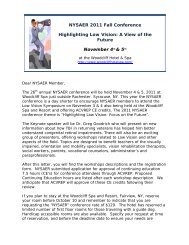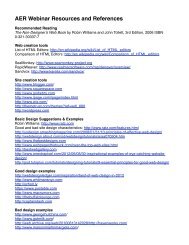Association for Education and Rehabilitation of the ... - AER Online
Association for Education and Rehabilitation of the ... - AER Online
Association for Education and Rehabilitation of the ... - AER Online
Create successful ePaper yourself
Turn your PDF publications into a flip-book with our unique Google optimized e-Paper software.
Family Perspectives on Cochlear Implants<br />
<strong>the</strong> incentive, a Web link to <strong>the</strong> survey instrument,<br />
<strong>and</strong> a Web link to opt out <strong>of</strong> survey participation. The<br />
first page <strong>of</strong> <strong>the</strong> survey reiterated <strong>the</strong> survey’s<br />
description <strong>and</strong> study’s purpose, as well as<br />
explaining all required in<strong>for</strong>med consent in<strong>for</strong>mation.<br />
A total <strong>of</strong> 75 electronic mail invitations were sent; 8<br />
were returned as ‘‘undeliverable.’’ Nine days later, a<br />
reminder e-mail was sent to each family who had not<br />
yet responded, <strong>for</strong> whom electronic mail addresses<br />
were available.<br />
Next, a paper copy <strong>of</strong> <strong>the</strong> survey invitation was<br />
sent to each <strong>of</strong> <strong>the</strong> families who did not respond to a<br />
second electronic invitation, or whose electronic mail<br />
address was no longer valid (n 5 32). Paper<br />
invitations included a letter describing <strong>the</strong> survey, <strong>the</strong><br />
purpose <strong>of</strong> <strong>the</strong> study, <strong>the</strong> researcher’s contact<br />
in<strong>for</strong>mation, in<strong>for</strong>mation regarding <strong>the</strong> incentive, <strong>and</strong><br />
a postage-paid return envelope. To help minimize<br />
differences between <strong>the</strong> two response modes, <strong>the</strong><br />
paper <strong>and</strong> pencil version <strong>of</strong> <strong>the</strong> survey was<br />
consistent in content, <strong>for</strong>mat, <strong>and</strong> layout to <strong>the</strong><br />
online version. Finally, attempts were made to<br />
contact, by telephone, each family who had not<br />
responded to <strong>the</strong> mailed invitation (n 5 18); families<br />
with whom contact was made in this manner (n 5 4)<br />
were asked all <strong>of</strong> <strong>the</strong> exact questions that appeared<br />
on <strong>the</strong> written survey. Each family who responded to<br />
<strong>the</strong> survey, in any <strong>for</strong>mat, received a small monetary<br />
compensation as a token <strong>of</strong> appreciation.<br />
Results<br />
Of <strong>the</strong> total number <strong>of</strong> families with whom contact<br />
was attempted (n 5 75), 71 families were reached<br />
successfully; contact was lost with 4 families. Each <strong>of</strong><br />
<strong>the</strong>se families has a child with deaf-blindness with at<br />
least one cochlear implant, <strong>for</strong> whom assessment<br />
in<strong>for</strong>mation was included in <strong>the</strong> cochlear implant<br />
study database. A total <strong>of</strong> 60 families (<strong>of</strong> <strong>the</strong> 71<br />
contacted) completed <strong>the</strong> survey—a response rate <strong>of</strong><br />
84.5 percent. Forty-three families completed <strong>the</strong><br />
survey online, 14 completed a paper survey, <strong>and</strong> 3<br />
families completed <strong>the</strong> survey via telephone interview.<br />
Seven families were nonresponders to all<br />
attempts at contact; four families entered a few<br />
responses to <strong>the</strong> survey but did not complete it.<br />
Process <strong>of</strong> Implantation<br />
Items addressing <strong>the</strong> process <strong>of</strong> implantation<br />
asked parents about <strong>the</strong> ease in obtaining referrals,<br />
86 | <strong>AER</strong> Journal: Research <strong>and</strong> Practice in Visual Impairment <strong>and</strong> Blindness<br />
insurance coverage, making appointments, <strong>and</strong><br />
locating services <strong>and</strong> if <strong>the</strong>y would make <strong>the</strong> same<br />
choice again (see Table 1 <strong>for</strong> a complete response<br />
summary). The most divisive survey item asked<br />
whe<strong>the</strong>r ‘‘<strong>the</strong> whole process <strong>of</strong> implantation is still<br />
stressful.’’ Of <strong>the</strong> 21 parents who agreed or strongly<br />
agreed <strong>the</strong> process remains stressful, 16 reported<br />
<strong>the</strong>ir child does enjoy wearing <strong>the</strong> implant; only 1 <strong>of</strong><br />
<strong>the</strong>se parents reported <strong>the</strong>ir child does not enjoy <strong>the</strong><br />
implant <strong>and</strong> 4 were neutral. The item with <strong>the</strong> highest<br />
level <strong>of</strong> agreement (88 percent) reported that most <strong>of</strong><br />
<strong>the</strong> parents found it easy to get a referral from <strong>the</strong>ir<br />
child’s doctor to <strong>the</strong> implant center. Most parents also<br />
reported that <strong>the</strong>y did not have difficulty with<br />
insurance or Medicaid, nor did <strong>the</strong>y need to seek a<br />
cochlear implant from more than one center (73<br />
percent <strong>and</strong> 85 percent, respectively). Regarding <strong>the</strong><br />
item stating that ‘‘knowing what <strong>the</strong>y now know, <strong>the</strong>y<br />
would again make <strong>the</strong> same decision’’ to seek a<br />
cochlear implant <strong>for</strong> <strong>the</strong>ir child, 85 percent agreed or<br />
strongly agreed. Only four participants disagreed or<br />
strongly disagreed with this statement; <strong>of</strong> <strong>the</strong>se, all<br />
four reported difficulty keeping <strong>the</strong> implant in place<br />
on <strong>the</strong>ir child, <strong>and</strong> three parents reported <strong>the</strong> child<br />
was not encouraged to wear <strong>the</strong> implant at school,<br />
one even noting <strong>the</strong> ‘‘teacher seems to think it is an<br />
unnecessary hassle.’’ Parents who agreed <strong>of</strong>fered<br />
tempered comments such as, ‘‘even though <strong>the</strong><br />
bilateral cochlear are considered failures by medical<br />
staff, [our son] enjoys hearing <strong>and</strong> uses <strong>the</strong>m <strong>for</strong><br />
environmental sound <strong>and</strong> we like that we can get his<br />
attention.’’ Parents who strongly agreed added<br />
enthusiastic comments such as, ‘‘Getting my son<br />
implanted was <strong>the</strong> best decision I have ever made!’’<br />
Child Outcomes<br />
Survey items related to child outcomes yielded<br />
varying responses. The item with <strong>the</strong> highest level <strong>of</strong><br />
agreement indicated that children were ‘‘attending to<br />
common sounds in <strong>the</strong> home’’ since receiving a<br />
cochlear implant (73 percent agreed or strongly<br />
agreed). Most parents disagreed that <strong>the</strong>ir children<br />
had improved <strong>the</strong>ir ‘‘participation in mealtime<br />
conversations’’ or ‘‘use <strong>of</strong> spoken language in <strong>the</strong><br />
home’’ (55 percent <strong>and</strong> 53 percent, respectively).<br />
Families more <strong>of</strong>ten agreed or strongly agreed that<br />
<strong>the</strong>ir child showed improvement in ‘‘respond(ing) to<br />
feelings expressed through vocal inflections’’ (67<br />
percent), ‘‘entertaining self by listening to music,<br />
watching television, or playing games’’ (62 percent),







